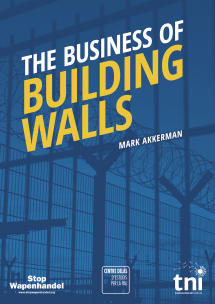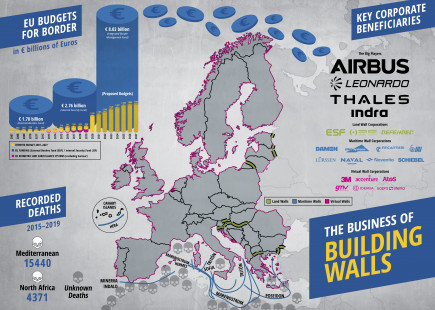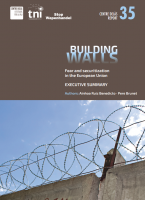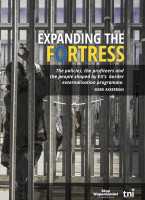The Business of Building Walls
Topics
Regions
Thirty years after the fall of the Berlin Wall, Europe is once again known for its border walls. This time Europe is divided not so much by ideology as by perceived fear of refugees and migrants, some of the world’s most vulnerable people.

Downloads
-
The Business of Building Walls (PDF, 7.26 MB)Average time to read: 45 minutes minutes
-
The Business of Building Walls: Executive summary (PDF, 1.07 MB)Average time to read: 10 minutes minutes
-
El Negocio de Construir Muros - Resumen Ejecutivo (PDF, 1.07 MB)Average time to read: 10 minutes minutes
-
Le Business de L'Édification de Murs - Synthése (PDF, 1.08 MB)Average time to read: 10 minutes minutes
Authors

Who killed the dream of a more open Europe? What gave rise to this new era of walls? There are clearly many reasons – the increasing displacement of people by conflict, repression and impoverishment, the rise of security politics in the wake of 9/11, the economic and social insecurity felt across Europe after the 2008 financial crisis – to name a few. But one group has by far the most to gain from the rise of new walls – the businesses that build them. Their influence in shaping a world of walls needs much deeper examination.
This report explores the business of building walls, which has both fuelled and benefited from a massive expansion of public spending on border security by the European Union (EU) and its member states. Some of the corporate beneficiaries are also global players, tapping into a global market for border security estimated to be worth approximately €17.5 billion in 2018, with annual growth of at least 8% expected in coming years.
It is important to look both beyond and behind Europe’s walls and fencing, because the real barriers to contemporary migration are not so much the fencing, but the vast array of technology that underpins it, from the radar systems to the drones to the surveillance cameras to the biometric fingerprinting systems. Similarly, some of Europe’s most dangerous walls are not even physical or on land. The ships, aircrafts and drones used to patrol the Mediterranean have created a maritime wall and a graveyard for the thousands of migrants and refugees who have no legal passage to safety or to exercise their right to seek asylum.
This renders meaningless the European Commission’s publicized statements that it does not fund walls and fences. Commission spokesperson Alexander Winterstein, for example, rejecting Hungary’s request to reimburse half the costs of the fences built on its borders with Croatia and Serbia, said: ‘We do support border management measures at external borders. These can be surveillance measures. They can be border control equipment...But fences, we do not finance’. In other words, the Commission is willing to pay for anything that fortifies a border as long as it is not seen to be building the walls themselves.
This report is a sequel to Building Walls – Fear and securitization in the European Union, co-published in 2018 with Centre Delàs and Stop Wapenhandel, which first measured and identified the walls that criss-cross Europe. This new report focuses on the businesses that have profited from three different kinds of wall in Europe:
- The construction companies contracted to build the land walls built by EU member states and the Schengen Area together with the security and technology companies that provide the necessary accompanying technology, equipment and services;
- The shipping and arms companies that provide the ships, aircraft, helicopters, drones that underpin Europe’s maritime walls seeking to control migratory flows in the Mediterranean, including Frontex operations, Operation Sophia and Italian operation Mare Nostrum;
- And the IT and security companies contracted to develop, run, expand and maintain EU’s systems that monitor the movement of people – such as SIS II (Schengen Information System) and EES (Entry/Exit Scheme) – which underpin Europe’s virtual walls.
Booming budgets
The flow of money from taxpayers to wall-builders has been highly lucrative and constantly growing. The report finds that companies have reaped the profits from at least €900 million spent by EU countries on land walls and fences since the end of the Cold War. The partial data (in scope and years) means actual costs will be at least €1 billion. In addition, companies that provide technology and services that accompany walls have also benefited from some of the steady stream of funding from the EU – in particular the External Borders Fund (€1.7 billion, 2007-2013) and the Internal Security Fund – Borders Fund (€2.76 billion, 2014-2020).
EU spending on maritime walls has totalled at least €676.4 million between 2006 to 2017 (including €534 million spent by Frontex, €28.4 million spent by the EU on Operation Sophia and €114 million spent by Italy on Operation Mare Nostrum) and would be much more if you include all the operations by Mediterranean country coastguards. Total spending on Europe’s virtual wall equalled at least €999.4m between 2000 and 2019. (All these estimates are partial ones because walls are funded by many different funding mechanisms and due to lack of data transparency).
This boom in border budgets is set to grow. Under its budget for the next EU budget cycle (2021–2027) the European Commission has earmarked €8.02 billion to its Integrated Border Management Fund (2021-2027), €11.27bn to Frontex (of which €2.2 billion will be used for acquiring, maintaining and operating air, sea and land assets) and at least €1.9 billion total spending (2000-2027) on its identity databases and Eurosur (the European Border Surveillance System).
The big arm industry players
Three giant European military and security companies in particular play a critical role in Europe’s many types of borders. These are Thales, Leonardo and Airbus.
- Thales is a French arms and security company, with a significant presence in the Netherlands, that produces radar and sensor systems, used by many ships in border security. Thales systems, were used, for example, by Dutch and Portuguese ships deployed in Frontex operations. Thales also produces maritime surveillance systems for drones and is working on developing border surveillance infrastructure for Eurosur, researching how to track and control refugees before they reach Europe by using smartphone apps, as well as exploring the use of High Altitude Pseudo Satellites (HAPS) for border security, for the European Space Agency and Frontex. Thales currently provides the security system for the highly militarised port in Calais. Its acquisition in 2019 of Gemalto, a large (biometric) identity security company, makes it a significant player in the development and maintenance of EU’s virtual walls. It has participated in 27 EU research projects on border security.
- Italian arms company Leonardo (formerly Finmeccanica or Leonardo-Finmeccanica) is a leading supplier of helicopters for border security, used by Italy in the Mare Nostrum, Hera and Sophia operations. It has also been one of the main providers of UAVs (or drones) for Europe’s borders, awarded a €67.1 million contract in 2017 by the European Maritime Safety Agency (EMSA) to supply them for EU coast-guard agencies. Leonardo was also a member of a consortium, awarded €142.1 million in 2019 to implement and maintain EU’s virtual walls, namely its EES. It jointly owns Telespazio with Thales, involved in EU satellite observation projects (REACT and Copernicus) used for border surveillance. Leonardo has participated in 24 EU research projects on border security and control, including the development of Eurosur.
- Pan-European arms giant Airbus is a key supplier of helicopters used in patrolling maritime and some land borders, deployed by Belgium, France, Germany, Greece, Italy, Lithuania and Spain, including in maritime Operations Sophia, Poseidon and Triton. Airbus and its subsidiaries have participated in at least 13 EU-funded border security research projects including OCEAN2020, PERSEUS and LOBOS.
- The significant role of these arms companies is not surprising. As Border Wars (2016), showed these companies through their membership of the lobby groups – European Organisation for Security (EOS) and the AeroSpace and Defence Industries Association of Europe (ASD) – have played a significant role in influencing the direction of EU border policy. Perversely, these firms are also among the top four biggest European arms dealers to the Middle East and North Africa, thus contributing to the conflicts that cause forced migration.
Indra has been another significant corporate player in border control in Spain and the Mediterranean. It won a series of contracts to fortify Ceuta and Melilla (Spanish enclaves in northern Morocco). Indra also developed the SIVE border control system (with radar, sensors and vision systems), which is in place on most of Spain's borders, as well as in Portugal and Romania. In July 2018 it won a €10 million contract to manage SIVE at several locations for two years. Indra is very active in lobbying the EU and is a major beneficiary of EU research funding, coordinating the PERSEUS project to further develop Eurosur and the Seahorse Network, a network between police forces in Mediterranean countries (both in Europe and Africa) to stop migration.
Israeli arms firms are also notable winners of EU border contracts. In 2018, Frontex selected the Heron drone from Israel Aerospace Industries for pilot-testing surveillance flights in the Mediterranean. In 2015, Israeli firm Elbit sold six of its Hermes UAVs to the Switzerland’s Border Guard, in a controversial €230 million deal. It has since signed a UAV contract with the European Maritime Safety Agency (EMSA), as a subcontractor for the Portuguese company CEIIA (2018), as well as contracts to supply technology for three patrol vessels for the Hellenic Coast Guard (2019).
Land wall contractors
Most of the walls and fences that have been rapidly erected across Europe have been built by national construction companies, but one European company has dominated the field: European Security Fencing, a Spanish producer of razor wire, in particular a coiled wire known as concertinas. It is most known for the razor wire on the fences around Ceuta and Melilla. It also delivered the razor wire for the fence on the border between Hungary and Serbia, and its concertinas were installed on the borders between Bulgaria and Turkey and Austria and Slovenia, as well as at Calais, and for a few days on the border between Hungary and Slovenia before being removed. Given its long-term market monopoly, its concertinas are very likely used at other borders in Europe.
Other contractors providing both walls and associated technology include DAT-CON (Croatia, Cyprus, Macedonia, Moldova, Slovenia and Ukraine), Geo Alpinbau (Austria/Slovenia), Indra, Dragados, Ferrovial, Proyectos Y Tecnología Sallén and Eulen (Spain/Morocco), Patstroy Bourgas, Infra Expert, Patengineeringstroy, Geostroy Engineering, Metallic-Ivan Mihaylov and Indra (Bulgaria/Turkey), Nordecon and Defendec (Estonia/Russia), DAK Acélszerkezeti Kft and SIA Ceļu būvniecības sabiedrība IGATE (Latvia/Russia), Gintrėja (Lithuania/Russia), Minis and Legi-SGS(Slovenia/Croatia), Groupe CW, Jackson’s Fencing, Sorhea, Vinci/Eurovia and Zaun Ltd (France/UK).
In many cases, the actual costs of the walls and associated technologies exceed original estimates. There have also been many allegations and legal charges of corruption, in some cases because projects were given to corporate friends of government officials. In Slovenia, for example, accusations of corruption concerning the border wall contract have led to a continuing three-year legal battle for access to documents that has reached the Supreme Court. Despite this, the EU’s External Borders Fund has been a critical financial supporter of technological infrastructure and services in many of the member states’ border operations. In Macedonia, for example, the EU has provided €9 million for patrol vehicles, night-vision cameras, heartbeat detectors and technical support for border guards to help it manage its southern border.
Maritime wall profiteers
The data about which ships, helicopters and aircraft are used in Europe’s maritime operations is not transparent and therefore it is difficult to get a full picture. Our research shows, however, that the key corporations involved include the European arms giants Airbus and Leonardo, as well as large shipbuilding companies including Dutch Damen and Italian Fincantieri.
Damen’s patrol vessels have been used for border operations by Albania, Belgium, Bulgaria, Portugal, the Netherlands, Romania, Sweden and the UK as well as in key Frontex operations (Poseidon, Triton and Themis), Operation Sophia and in supporting NATO’s role in Operation Poseidon. Outside Europe, Libya, Morocco, Tunisia and Turkey use Damen vessels for border security, often in cooperation with the EU or its member states. Turkey’s €20 million purchase of six Damen vessels for its coast guard in 2006, for example, was financed through the EU Instrument contributing to Stability and Peace (IcSP), intended for peace-building and conflict prevention.
The sale of Damen vessels to Libya unveils the potential troubling human costs of this corporate trade. In 2012, Damen supplied four patrol vessels to the Libyan Coast Guard, sold as civil equipment in order to avoid a Dutch arms export license. Researchers have since found out, however, that the ships were not only sold with mounting points for weapons, but were then armed and used to stop refugee boats. Several incidents involving these ships have been reported, including one where some 20 or 30 refugees drowned. Damen has refused to comment, saying it had agreed with the Libyan government not to disclose information about the ships.
In addition to Damen, many national shipbuilders play a significant role in maritime operations as they were invariably prioritised by the countries contributing to each Frontex or other Mediterranean operation. Hence, all the ships Italy contributed to Operation Sophia were built by Fincantieri, while all Spanish ships come from Navantia and its predecessors. Similarly, France purchases from DCN/DCNS, now Naval Group, and all German ships were built by several German shipyards (Flensburger Schiffbau-Gesellschaft, HDW, Lürssen Gruppe). Other companies in Frontex operations have included Greek company, Motomarine Shipyards, which produced the Panther 57 Fast Patrol Boats used by the Hellenic Coast Guard, Hellenic Shipyards and Israel Shipyards.
Austrian company Schiebel is a significant player in maritime aerial surveillance through its supply of S-100 drones. In November 2018, EMSA selected the company for a €24 million maritime surveillance contract for a range of operations including border security. Since 2017, Schiebel has also won contracts from Croatia, Denmark, Iceland, Italy, Portugal and Spain. The company has a controversial record, with its drones sold to a number of countries experiencing armed conflict or governed by repressive regimes such as Libya, Myanmar, the UAE and Yemen.
Finland and the Netherlands deployed Dornier aircraft to Operation Hermes and Operation Poseidon respectively, and to Operation Triton. Dornier is now part of the US subsidiary of the Israeli arms company Elbit Systems. CAE Aviation (Luxembourg), DEA Aviation (UK) and EASP Air (Netherlands) have all received contracts for aircraft surveillance work for Frontex. Airbus, French Dassault Aviation, Leonardo and US Lockheed Martin were the most important suppliers of aircraft used in Operation Sophia.
The EU and its member states defend their maritime operations by publicising their role in rescuing refugees at sea, but this is not their primary goal, as Frontex director Fabrice Leggeri made clear in April 2015, saying that Frontex has no mandate for ‘proactive search-and-rescue action[s]’ and that saving lives should not be a priority. The thwarting and criminalisation of NGO rescue operations in the Mediterranean and the frequent reports of violence and illegal refoulement of refugees, also demonstrates why these maritime operations should be considered more like walls than humanitarian missions.
Virtual walls
The major EU contracts for the virtual walls have largely gone to two companies, sometimes as leaders of a consortium. Sopra Steria is the main contractor for the development and maintenance of the Visa Information System (VIS), Schengen Information System (SIS II) and European Dactyloscopy (Eurodac), while GMV has secured a string of contracts for Eurosur. The systems they build help control, monitor and surveil people's movements across Europe and increasingly beyond.
Sopra Steria is a French technology consultancy firm that has to date won EU contracts worth a total value of over €150 million. For some of these large contracts Sopra Steria joined consortiums with HP Belgium, Bull and 3M Belgium. Despite considerable business, Sopra Steria has faced considerable criticism for its poor record on delivering projects on time and on budget. Its launch of SIS II was constantly delayed, forcing the Commission to extend contracts and increase budgets. Similarly, Sopra Steria was involved in another consortium, the Trusted Borders consortium, contracted to deliver the UK e-Borders programme, which was eventually terminated in 2010 after constant delays and failure to deliver. Yet it continues to win contracts, in part because it has secured a near-monopoly of knowledge and access to EU officials. The central role that Sopra Steria plays in developing these EU biometric systems has also had a spin-off effect in securing other national contracts, including with Belgium, Bulgaria, Czech Republic, Finland, France, Germany, Romania and Slovenia GMV, a Spanish technology company, has received a succession of large contracts for Eurosur, ever since its testing phase in 2010, worth at least €25 million. It also provides technology to the Spanish Guardia Civil, such as control centres for its Integrated System of External Vigilance (SIVE) border security system as well as software development services to Frontex. It has participated in at least ten EU-funded research projects on border security.
Most of the large contracts for the virtual walls that did not go to consortia including Sopra Steria were awarded by eu-LISA (European Union Agency for the Operational Management of Large-Scale IT Systems in the Area of Freedom, Security and Justice) to consortia comprising computer and technology companies including Accenture, Atos Belgium and Morpho (later renamed Idema).
Lobbying
As research in our Border Wars series has consistently shown, through effective lobbying, the military and security industry has been very influential in shaping the discourse of EU security and military policies. The industry has succeeded in positioning itself as the experts on border security, pushing the underlying narrative that migration is first and foremost a security threat, to be combatted by security and military means. With this premise, it creates a continuous demand for the ever-expanding catalogue of equipment and services the industry supplies for border security and control.
Many of the companies listed here, particularly the large arms companies, are involved in the European Organisation for Security (EOS), the most important lobby group on border security. Many of the IT security firms that build EU’s virtual walls are members of the European Biometrics Association (EAB). EOS has an ‘Integrated Border Security Working Group’ to ‘facilitate the development and uptake of better technology solutions for border security both at border checkpoints, and along maritime and land borders’. The working group is chaired by Giorgio Gulienetti of the Italian arms company Leonardo, with Isto Mattila (Laurea University of Applied Science) and Peter Smallridge of Gemalto, a digital security company recently acquired by Thales.
Company lobbyists and representatives of these lobby organisations regularly meet with EU institutions, including the European Commission, are part of official advisory committees, publish influential proposals, organise meetings between industry, policy-makers and executives and also meet at the plethora of military and security fairs, conferences and seminars. Airbus, Leonardo and Thales together with EOS held 226 registered lobbying meetings with the European Commission between 2014 and 2019. In these meetings representatives of the industry position themselves as the experts on border security, presenting their goods and services as the solution for ‘security threats’ caused by immigration. In 2017, the same group of companies and EOS spent up to €2.65 million on lobbying.
A similar close relationship can be seen on virtual walls, with the Joint Research Centre of the European Commission arguing openly for public policy to foster the ‘emergence of a vibrant European biometrics industry’.
A deadly trade and a choice
The conclusion of this survey of the business of building walls is clear. A Europe full of walls has proved to be very good for the bottom line of a wide range of corporations including arms, security, IT, shipping and construction companies. The EU’s planned budgets for border security for the next decade show it is also a business that will continue to boom.
This is also a deadly business. The heavy militarisation of Europe’s borders on land and at sea has led refugees and migrants to follow far more hazardous routes and has trapped others in desperate conditions in neighbouring countries like Libya. Many deaths are not recorded, but those that are tracked in the Mediterranean show that the proportion of those who drown trying to reach Europe continues to increase each year.
This is not an inevitable state of affairs. It is both the result of policy decisions made by the EU and its member states, and corporate decisions to profit from these policies. In a rare principled stand, German razor wire manufacturer Mutanox in 2015 stated it would not sell its product to the Hungarian government arguing: ‘Razor wire is designed to prevent criminal acts, like a burglary. Fleeing children and adults are not criminals’. It is time for other European politicians and business leaders to recognise the same truth: that building walls against the world’s most vulnerable people violates human rights and is an immoral act that history will judge harshly. Thirty years after the fall of the Berlin Wall, it is time for Europe to bring down its new walls.




